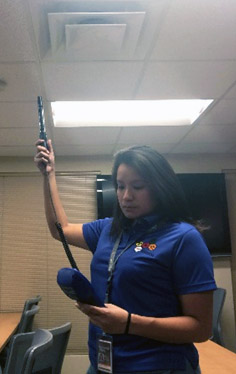Indoor Air Quality (IAQ)
 The quality of indoor air inside offices, schools, and other workplaces is important not only for workers' comfort but also for their health. Poor indoor air quality (IAQ) has been tied to symptoms like headaches, fatigue, trouble concentrating, and irritation of the eyes, nose, throat and lungs. Also, some specific diseases have been linked to specific air contaminants or indoor environments, like asthma with damp indoor environments. In addition, some exposures, such as asbestos and radon, do not cause immediate symptoms but can lead to cancer after many years. The University of Texas Rio Grande Valley (UTRGV) endeavors to maintain favorable indoor air quality for all building occupants in all owned or leased indoor air environments.
The quality of indoor air inside offices, schools, and other workplaces is important not only for workers' comfort but also for their health. Poor indoor air quality (IAQ) has been tied to symptoms like headaches, fatigue, trouble concentrating, and irritation of the eyes, nose, throat and lungs. Also, some specific diseases have been linked to specific air contaminants or indoor environments, like asthma with damp indoor environments. In addition, some exposures, such as asbestos and radon, do not cause immediate symptoms but can lead to cancer after many years. The University of Texas Rio Grande Valley (UTRGV) endeavors to maintain favorable indoor air quality for all building occupants in all owned or leased indoor air environments.
In an effort to ensure a work environment that has favorable indoor air quality, the University has established a Formal Indoor Air Quality program designed to 1) identify any potential indoor air quality related issues and 2) work with facilities to expeditiously address them. UTRGV’s goal is to operate buildings in a manner that meets established performance standards regarding ventilation, temperature, relative humidity, air quality, odor, noise, and lighting.
Poor Indoor Air Quality
Indoor environmental quality (IEQ) concerns are generally related to ventilation systems, the air, materials, and operations inside a building, moisture intrusion, and individual sensitivities. Other issues can be attributed to noise, transient odors from paint, roof repair, construction, lighting, workstation design, or job stress. People working in offices or buildings with poor IAQ may notice unpleasant or musty odors or may feel that the building is hot and stuffy. Some workers complain about symptoms that happen at work and go away when they leave work, like having headaches or feeling tired. Fever, cough, and shortness of breath can be symptoms of a more serious problem. Asthma and some causes of pneumonia (for example, Legionnaires’ disease and Hypersensitivity Pneumonitis) have been linked to IAQ problems.
Sick building syndrome (SBS) is a medical condition where people in a building suffer from symptoms of illness or feel unwell for no apparent reason. The symptoms tend to increase in severity with the time people spend in the building, and decrease over time or even disappear when people are away from the building.
Reporting IAQ Issues
If you have symptoms that may be attributed to poor indoor air quality, notify the UTRGV Environmental Health, Safety, & Risk Management (EHSRM) Occupational Health and Safety Program at (956) 665-2904. EHSRM will in turn
- Visit the location and conduct a routine IAQ survey to determine if the comfort parameters (temperature, relative humidity, carbon dioxide, carbon monoxide) are in line with ASHRAE recommended standards.
- Conduct an initial investigations of the building HVAC systems, and check the general condition of the complaint area and,
- If necessary, conduct an occupant survey to determine if the issues are building wide.
The EHSRM will then work with Facilities to address any incorrectly functioning building equipment that may be contributing to poor IAQ.
Regulations
The Environmental Protection Agency and the Occupational Safety and Health Administration have not promulgated regulations for indoor air quality. Assessment and resolution of indoor environmental quality issues are based on professional guidelines and industry best practices.
Indoor Air Quality Program Documents
- UTRGV – Indoor Air Quality Program Manual
- UTRGV – Indoor Air Quality Occupant Survey
- UTRGV - Proactive Characterization and Resolution of IAQ Related Problems
